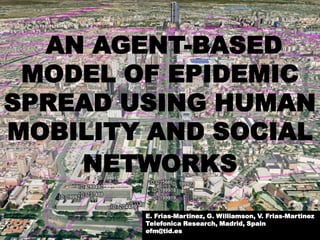
An Agent-Based Model of Epidemic Spread using Human Mobility and Social Network Information
- 1. AN AGENT-BASED MODEL OF EPIDEMIC SPREAD USING HUMAN MOBILITY AND SOCIAL NETWORKS E. Frias-Martinez, G. Williamson, V. Frias-Martinez Telefonica Research, Madrid, Spain efm@tid.es
- 2. Epidemic Disease Models Compartmental Models (SEIR) Susceptible Exposed Infectious Recovered Contact Transition Recovery Rate Rate Rate Agent Based Models Capure complexity of social interaction Limitation with the information available to generate the agents
- 3. Digital Footprints For the first time in human history, we have access to large-scale human behavioral data at varying levels of spatial and temporal granularities
- 4. Ce ll Phone N e t w ork Cell Phone networks are built using Base Transceiver Stations (BTS) Each BTS will be characterized by a feature vector that describes t calling behavior area.
- 5. 2233445566|3E884DB|15/02/2011|23:02:35|... 2233445567|3E884DC|16/02/2011|23:02:35|... 2233445568|3E884DD|17/02/2011|23:02:35|... 2233445569|3E884E5|18/02/2011|23:02:35|... URBAN 1-4km²
- 7. ABM for Virus Spreading using CDR Mobility Model Social Network Model Disease Model
- 8. M3 S3 D3 M2 S2 D2 M1 S1 D1 Social Network Mobility Model Disease Model Model t₀ t₁ t₂ t₃ … t₉ (1 hour) Identify geographical location (BTS) Identify peers in same BTS If peer in SN then evolve disease model with p_i Else evolve disease model with p_j
- 9. Closed Reopen Preflu 27th April 6th May Alert Shutdown 17th April 1st May Measure the impact that government alerts had on the population Flu is very good candidate to be modelled by SEIR
- 10. Call Detail Records from 1st Jan. till 31st.May 2009 Compute mobility and social models Baseline scenario Intervention scenario Simulation April 17th to May 16th “Evolve” disease and evaluate impact in Agent’s mobility Disease transmission Spatio-temporal evolution
- 11. Agent Generation Call Detail Records from 1st Jan. till 31st.May 2009 Granularity of 1 hour 20% of slots filled /0.25 calls per hour Agents active during the different time periods Final number of agents: 25,000 Reproduction number / Latent period / infectious period obtained from the literature.
- 12. April 27th May 1st May 6th Mobility reduced between 10% and 30% Alert Closed Shutdown Reopen Intervention
- 13. Baseline (“preflu” behavior all weeks) Intervention (alert,closed,shutdown) Epidemic peak postponed 40 hours Reduced number of infected in peak agents by 10%
- 14. March 8thMay 14th April 29th May 3rd
- 15. Future
- 16. Enriched Agents (Gender, Age, Vaccinations) Methodology for studying spatio-temporal evolution.
Hinweis der Redaktion
- As opposed to economic costs
- Percentage of subscribers that move from one bts to anotherOne in the 1hour time slot
